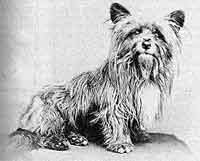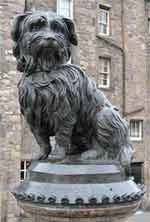Greyfriars Bobby
 Even since the first wild dog came sniffing around a stone age camp fire looking for scraps our relationship with these animals has been a close one. Many stories exist of this bond between man and dog and Scotland has its fair share. However the most famous by far was Bobby – the Skye Terrier.
Even since the first wild dog came sniffing around a stone age camp fire looking for scraps our relationship with these animals has been a close one. Many stories exist of this bond between man and dog and Scotland has its fair share. However the most famous by far was Bobby – the Skye Terrier.
Bobby first appeared in Edinburgh around the 1850s at the side of John Gray; a shepherd who came to the capital, trading his crook for a truncheon he joined the police force, preferring to herd criminals than sheep! Edinburgh in this time, especially the old town where Gray and his faithful dog patrolled was no place for the feint hearted. The scandal of Burke & Hare were still fresh in the mind and many other notorious criminals stalked the squalid streets of ‘Auld Reekie’ Gray found lodging in the Cowgate a narrow cavernous street that runs under the impressive ‘Bridges’. The street was given this name as it led down towards the pasture land past the Eastern city walls. As the city had grown this once magnificent walkway had been almost buried by the architecture that sprang up on either side. This was certainly not one of the better parts of the city and any man (and dog) had to be capable of looking after themselves to live there.
 The area from the Cowgate westward to the Grassmarket nearby was a popular market with sheep and cattle driven down from the highlands for trade – rustling was common and John Gray and Bobby patrolled this area at night keeping the peace. When his watch ended Gray frequented a small eating house at nearby Greyfriars Place where both were given good hospitality. For many years the two were regular customers. John became known to all as ‘Old Jock’ and Bobby became a firm favourite of all the children that played around these streets.
The area from the Cowgate westward to the Grassmarket nearby was a popular market with sheep and cattle driven down from the highlands for trade – rustling was common and John Gray and Bobby patrolled this area at night keeping the peace. When his watch ended Gray frequented a small eating house at nearby Greyfriars Place where both were given good hospitality. For many years the two were regular customers. John became known to all as ‘Old Jock’ and Bobby became a firm favourite of all the children that played around these streets.
However there was one villain lurking in these streets that ‘Jock’ could not defeat – the poor housing in the old town harboured a number of diseases and John Gray eventually succumbed to Tuberculosis. He was invalided out of the force and died in his lodging house in 1858.
Gray’s funeral was attended by a guard of honour from the police force and Bobby marched with the procession up Candlemaker Row to the kirkyard at Greyfriars. Bobby would almost certainly not have been permitted to follow the procession into the kirkyard as dogs would not have been allowed, however at night when he was let out from the lodging house that he had now been adopted in he made straight for Greyfriars – scrambled under the gates and found the grave of his master.
He was discovered the next morning and evicted from the grounds but almost as soon as he was out he found another way back in and resumed his place with determination. this ritual was performed many times before the church elders finally gave up and permitted Bobby to maintain his vigil. He was still a regular at the eating house in Greyfriars place, owned by Mr Traill.
As time passed Bobby’s fame spread – visitors to the churchyard would always have a scrap of food for the ‘wee doggie’ and the patrolling ‘bobbies’ would nearly always make a detour through the cemetery to pay respects to John and Bobby. Only when the worst of the winter weather gripped the city did Bobby give up his graveside location.
Visitors (any many locals) in Edinburgh have no doubt jumped at the stroke of one o’clock when the one o’clock gun is fired from Edinburgh castle. This long running tradition was used as a time signal, particularly useful for ships in the nearly port of Leith but the signal was also used by Bobby as ‘dinner time’. He was frequently joined by William Dow, A cabinet maker who worked at George Heriots School on the other side of the kirkyard. Soon Bobby got used to looking out for his friend and would be waiting for him at the gates when the gun was fired.
So this relationship continued until someone less charitable pointed out to the authorities that Bobby had no license and since no owner could be traced the poor dog was ‘arrested’. The mean spirited act caused an outrage. The dog’s own free nature meant that it seemed attached to no-one but his dead master so no matter how hard they tried no on person could satisfactorily claim ownership. Students at the University began collecting towards a license for the dog and William Chambers, Lord Provost of Edinburgh presented Bobby with his own engraved collar with the license attached. Bobby belonged to everyone and had the freedom of the city.

Bobby never gave up his vigil and he finally died in 1872 at Mr Traill’s home in Kier Street just to the west of Greyfriars. There is a rumour that he was secretly buried in a quiet corner Greyfriars kirkyard. A stone was later erected near the entrance with this inscription:
Greyfriars Bobby Died 14th January 1872 Aged 16 Years Let his Loyalty and Devotion Be a Lesson to us all
Erected by the Dog Aid Society of Scotland and Unveiled by H.R.H., The Duke of Gloucestor G.C.V.O. on 13th May 1981
Just across from the entrance to Greyfriars there is a more famous monument – the statue of little Bobby himself. He has become one of most lasting icons of Edinburgh and his likeness is as well known as all the famous dignitaries whose monuments pepper the streets of Scotland’s capital.
